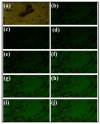Upconversion Emission Studies in Er3+/Yb3+ Doped/Co-Doped NaGdF4 Phosphor Particles for Intense Cathodoluminescence and Wide Temperature-Sensing Applications
- PMID: 36233905
- PMCID: PMC9570846
- DOI: 10.3390/ma15196563
Upconversion Emission Studies in Er3+/Yb3+ Doped/Co-Doped NaGdF4 Phosphor Particles for Intense Cathodoluminescence and Wide Temperature-Sensing Applications
Abstract
Er3+/Yb3+ doped/co-doped NaGdF4 upconversion phosphor nanoparticles were synthesized via the thermal decomposition route of synthesis. The α-phase crystal structure and nanostructure of these particles were confirmed using XRD and FE-SEM analysis. In the power-dependent upconversion analysis, different emission bands at 520 nm, 540 nm, and 655 nm were obtained. The sample was also examined for cathodoluminescence (CL) analysis at different filament currents of an electron beam. Through CL analysis, different emission bands of 526 nm, 550 nm, 664 nm, and 848 nm were obtained. The suitability of the present sample for temperature-sensing applications at a wide range of temperatures, from room temperature to 1173 K, was successfully demonstrated.
Keywords: NaGdF4:Er3+/Yb3+; cathodoluminescence; luminescence; temperature sensor; upconversion.
Conflict of interest statement
The authors declare no conflict of interest.
Figures








References
-
- Kumar A., Couto M.H.M., Tiwari S.P., Kumar K., Esteves da Silva J.C.G. Effect of pH of precursor on up/downconversion and cathodoluminescence of Gd2O3:Ho3+/Yb3+ phosphor and magneto-optic studies. ChemistrySelect. 2018;3:10566–10573. doi: 10.1002/slct.201801556. - DOI
-
- Han Q., Jianxia W.G., Zhao Q.X., Zhang J., Wang Y., Dong S., Liu W., Hao A., Dong J. Enhanced luminescence of a new red phosphor Na13Sr2Ta2(PO4)9:Eu3+ by co-doping charge compensators Li+/Na+/K+ J. Lumin. 2019;212:227–232. doi: 10.1016/j.jlumin.2019.04.039. - DOI
-
- Zhang N., Molokeev M.S., Liu Q., Xia Z. Pure red upconversion luminescence and optical thermometry of Er3+ doped sensitizer-rich SrYbInO4 phosphors. J. Mater. Chem. C. 2018;6:7361–7366. doi: 10.1039/C8TC02565G. - DOI
Grants and funding
LinkOut - more resources
Full Text Sources

